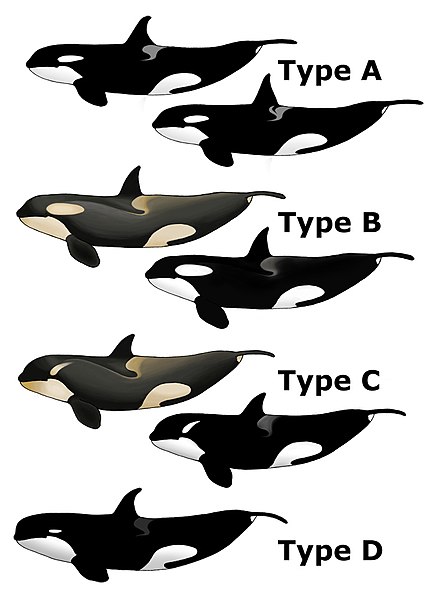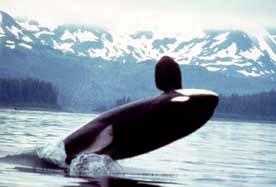The killer whale (Orcinus orca), also
referred to as the orca whale or orca, and less
commonly as the blackfish or grampus, is atoothed whale belonging
to the oceanic
dolphin family. Killer whales are found in all oceans, from the
frigid Arctic and Antarctic regions
to tropical seas. Killer whales as a species have a diverse diet, although
individual populations often specialize in particular types of prey. Some feed
exclusively on fish, while others hunt marine mammals like pinnipeds, and even
large whales. Killer
whales are regarded as apex
predators, lacking natural predators.
due to prey depletion, habitat loss,
pollution (byPCBs), capture for marine mammal parks, and conflicts
with fisheries. In late
2005, the "southern resident" population of killer whales
that inhabits British Columbia and Washington state waters were placed on the
U.S. Endangered Species list. Wild killer whales are not considered a threat to
humans.
|
Killer whale[1]
|
|
|
Transient killer whales near Unimak Island, eastern Aleutian Islands,
Alaska
|
|
|
Size compared to an average human
|
|
|
Kingdom:
|
|
|
Phylum:
|
|
|
Class:
|
|
|
Order:
|
|
|
(unranked):
|
|
|
(unranked):
|
|
|
Family:
|
|
|
Genus:
|
|
|
Species:
|
O. orca
|
|
Orcinus orca range (in blue)
|
|
|
Orca gladiator
|
|
Orcinus orca is the only
recognized extant species
in the genus Orcinus, one of many animal species originally
described by Linnaeus in
1758 in Systema
Naturae. The killer whale is one of 35 species in the oceanic dolphin family,
which first appeared about 11 million years ago. The killer whale lineage
probably branched off shortly thereafter.[13] Although
it has morphological similarities
with the pygmy
killer whale, the false
killer whale and the pilot whales, a
study of cytochrome
b gene sequences by Richard LeDuc indicated that its closest
extant relatives are the snubfin
dolphins of the genus Orcaella.[17]
Common names
English-speaking scientists most often use the term "killer
whale", although the term "orca" is increasingly
used. Ancient Romans originally
applied orca (pluralorcae) to these animals, possibly
borrowing it from the Greek ὄρυξ, which referred (among other things) to a
whale species; both names are now used. The term orca is preferred by some to
avoid the negative connotations of "killer",[20] and
because, being part of the family Delphinidae, the
species is more closely related to other dolphins than to whales.[21]
Types
The three to five types of killer whales may be distinct enough
to be considered different races,[24] subspecies, or
possibly even species.[25] The IUCN reported in 2008, "The taxonomy
of this genus is clearly in need of review, and it is likely that O.
orca will be split into a number of different species or at least
subspecies over the next few years, research off the west coast of Canada
and the United States in the 1970s and 1980s identified the following three
types:
· Resident: These are the most commonly sighted of the three populations
in the coastal waters of the northeast Pacific Female residents
characteristically have rounded dorsal fin tips that terminate in a sharp
corner.
· Transient: The diets of these whales consist almost exclusively of marine mammals.[27][29] Transients
generally travel in small groups, usually of two to six animals, and have less
persistent family bonds than residents.[31] Transients
vocalize in less variable and less complex dialects.[32] Female
transients are characterized by more triangular and pointed dorsal fins than
those of residents.[29] The
saddle patches of transients are solid and uniformly gray.[29]
· Offshore: Offshores typically congregate in groups of 20–75, with
occasional sightings of larger groups of up to 200.[38] Currently,
little is known about their habits, but they are genetically distinct from
residents and transients. Offshores appear to be smaller than the others, and
females are characterized by dorsal fin tips
that are continuously rounded.[29]
Some examples of
variations in killer whales
· Type A looks like a "typical" killer whale, a large,
black and white form with a medium-sized white eye patch, living in open water
and feeding mostly on minke
whales.[25]
· Type B is smaller than type A. It has a large white eye patch.
Most of the dark parts of its body are medium gray instead of black, although
it has a dark gray patch called a "dorsal cape"[50] stretching
back from its forehead to just behind its dorsal fin. The white areas are
stained slightly yellow. It feeds mostly on seals.[25]
· Type C is the smallest type and lives in larger groups than the
others. Its eye patch is distinctively slanted forwards, rather than parallel
to the body axis. Like type B, it is primarily white and medium gray, with a
dark gray dorsal cape and yellow-tinged patches. Its only observed prey is
the Antarctic
cod.[25]
· Type D was identified based on photographs of a 1955 mass
stranding in New Zealand and six at-sea sightings since 2004. The first video
record of this type in life happened between the Kerguelen and Crozet Islands in
2014.[51] It
is immediately recognizable by its extremely small white eye patch, narrower and
shorter than usual dorsal fin, bulbous head (similar to a pilot whale), and
smaller teeth.[52] Its
geographic range appears to be circumglobal in subantarctic waters between latitudes 40°S and 60°S.
And although nothing is known about the type D diet, it is suspected to include
fish because groups have been photographed around longline vessels where they
reportedly prey on Patagonian
toothfish (Dissostichus eleginoides).[53][54]
Appearance and
morphology
Internal anatomy of an
orca
A typical killer whale distinctively bears a black back, white
chest and sides, and a white patch above and behind the eye. Calves are born
with a yellowish or orange tint, which fades to white. It has a heavy and
robust body[60] with
a large dorsal fin up to 2 m (6.6 ft) tall. Behind the fin, it has a
dark grey "saddle patch" across the back. Antarctic killer whales may
have pale grey to nearly white backs. Adult killer whales are very distinctive
and are not usually confused with any other sea creature.[61]When seen
from a distance, juveniles can be confused with other cetacean species,
such as the false
killer whale or Risso's dolphin.[62] The
killer whale's teeth are very strong and covered in enamel. Its jaws are
a powerful gripping apparatus, as the upper teeth fall into the gaps between
the lower teeth when the mouth is closed. The front teeth are inclined slightly
forward and outward, thus allowing the killer whale to withstand powerful
jerking movements from its prey while the middle and back teeth hold it firmly
in place.[63]
Killer whales are the largest extant members of the dolphin
family. Males typically range from 7 to 9 metres (23 to 30 ft) long and
weigh in excess of 6 tonnes (5.9 long tons; 6.6 short tons). Females are
smaller, generally ranging from 6 to 8 m (20 to 26 ft) and weighing
about 3 to 4 tonnes (3.0 to 3.9 long tons; 3.3 to 4.4 short tons).[64] The
largest male killer whale on record was 9.8 m (32 ft), weighing over
10 tonnes (9.8 long tons; 11 short tons), while the largest female was
8.5 m (28 ft), weighing 7.5 tonnes (7.4 long tons; 8.3 short tons).[65] Calves
at birth weigh about 180 kg (400 lb) and are about 2.4 m
(7.9 ft) long.[66][67] The
killer whale's large size and strength make it among the fastest marine
mammals, able to reach speeds in excess of 56 km/h (30 kn).[68] The
skeleton of the killer whale is of the typical delphinid structure, but is more
robust.[69] Its integument, unlike
that of most other dolphin species, is characterised by a well-developed dermal
layer with a dense network of fascicles of collagen fibers.[70]
Killer whale pectoral fins are
large and rounded, resembling paddles. Males have significantly larger pectoral
fins than females. At about 1.8 m (5.9 ft) the male's dorsal fin is
more than twice the size of the female's and is more of a triangular shape—a
tall, elongated isosceles triangle—whereas hers is shorter and more curved.[71] Males
and females also have different patterns of black and white skin in their
genital areas.[72] Sexual dimorphism is
also apparent in the skull; adult males have longer lower jaws than females,
and have larger occipital crests.[70]
An individual killer whale can often be identified from its
dorsal fin and saddle patch. Variations such as nicks, scratches, and tears on
the dorsal fin and the pattern of white or grey in the saddle patch are unique.
Published directories contain identifying photographs and names for hundreds of
North Pacific animals. Photographic identification has enabled the local
population of killer whales to be counted each year rather than estimated, and
has enabled great insight into lifecycles and social structures.[73]
White killer whales occur sporadically but rarely among normal
killer whales; they have been spotted in the northern Bering Sea and
around St.
Lawrence Island, and near theRussian coast.[38][74] In
February 2008, a white killer whale was photographed 3.2 km (2.0 mi)
off Kanaga Volcano
in the Aleutian
Islands.[38][74]
Killer whales have good eyesight above and below the water,
excellent hearing, and a good sense of touch. They have exceptionally
sophisticated echolocation abilities,
detecting the location and characteristics of prey and other objects in their
environments by emitting clicks and listening for echoes.[75]
The mean body temperature of the orca is 36 to 38 °C (97 to
100 °F).[76][77] Like
most marine mammals, orcas have a layer of insulating blubber ranging from 7.6
to 10 cm (3.0 to 3.9 in) thick[76] beneath
its skin.
The heart beats at a rate of about 60 beats/min when the orca is
at the surface, dropping to 30 beats/min when submerged.[78]
Range and habitat
A killer whale leaps
out of the water when swimming—a behaviour known as porpoising
Killer whales are found in all oceans and most seas. Due to
their enormous range, numbers, and density, distributional
estimates are difficult to compare,[90] but
they clearly prefer higher latitudes and coastal areas over pelagic environments.[91]
Systematic surveys indicate the highest densities of killer
whales (>0.40 individuals per 100 km²) in the northeast Atlantic around
theNorwegian coast,
in the north Pacific along the Aleutian Islands,
the Gulf
of Alaska and in the Southern Ocean off
much of the coast ofAntarctica.[90] They
are considered "common" (0.20–0.40 individuals per 100 km²) in
the eastern Pacific along the coasts of British Columbia, Washington and Oregon, in the North Atlantic Ocean
around Iceland and
the Faroe
Islands. High densities have also been reported but not quantified
in the western North Pacific around the Sea of Japan (in
very limited areas), Shiretoko
Peninsula and offKushiro (Resident
and Transient groups began colonizing in these areas possibly after in
2000s), Sea
of Okhotsk, Kuril
Islands, Kamchatkaand
the Commander
Islands and in the Southern Hemisphere off the coasts of South Australia, Patagonia, off the
coast of southern Braziland
the tip of southern
Africa. They are reported as seasonally common in the Canadian Arctic,
including Baffin
Bay between Greenlandand Nunavut, and
around Tasmania and Macquarie Island.[90] Information
for offshore regions and tropical waters is more scarce, but widespread, if not
frequent, sightings indicate the killer whale can survive in most water
temperatures. They have been sighted, for example, in the Mediterranean,
the Arabian Sea,
the Gulf
of Mexico and the Indian Ocean around
the Seychelles.[90] A
distinct population may exist in Papua New Guinea.[92][93]
Population structure in mid to lower latitudes of the North
Pacific is unclear especially in coastal waters. Large concentrations are known
to occur north of the Northern Mariana Islands[94] and
in the Gulf of Sendai,[95] and
repeated sightings are reported off Bali,[96] the
east coast of Taiwan, Ryukyu Islands,[97] Izu Islands,[98] in Tsushima Strait,[99] and Izu Peninsula.[100]
Occasionally, killer whales swim into freshwater rivers. They
have been documented 100 mi (160 km) up the Columbia River in
the United States.[104][105] They
have also been found in the Fraser River in
Canada and the Horikawa
River in Japan.[104]
Feeding
Killer whales are apex predators,
meaning that they themselves have no natural predators. They are sometimes
called the wolves of the
sea, because they hunt in groups like wolf packs.[109] Killer
whales hunt varied prey including fish, cephalopods,
mammals, sea birds andsea turtles.[110] However,
different populations or species tend to specialize and some can have a
dramatic impact on certain prey species.[111] Those
that feed on mammals may not even recognize fish as food. This specialization
in diet and hunting, combined with small differences in markings, suggest that
they might be different species, rather than populations. Advanced methods that
sequenced the entire mitochondrial genome revealed systematic differences in
DNA between different populations.[59]
Fish
Tail-slapping in Vestfjorden, Norway
Fish-eating killer whales prey on around 30 species of fish.
Some populations in the Norwegian andGreenland sea
specialize in herring and
follow that fish's autumnal migration to the Norwegian coast. Salmon account for 96% of northeast
Pacific residents' diet. About 65% of them are large, fatty Chinook.[112] Chum salmon are
also eaten, but smaller sockeye and pink salmon are
not a significant food item.[113]
Mammals and birds
Killer whales are very sophisticated and effective predators
of marine
mammals. Thirty-two cetacean species
have been recorded as killer whale prey, from examining eitherstomach contents, scarring on the prey's body, or feeding
activity
Behavior
Day-to-day killer whale behavior generally consists of foraging,
travelling, resting and socializing. Killer whales are frequently active at the
surface, engaging in acrobatic behaviors such as breaching, spyhopping, and
tail-slapping.
Social structure
Killer whales are notable for their complex societies.
Only elephants and
higher primates, such as
humans, live in comparably complex social structures.[81] Due
to orcas' complex social bonds and society, many marine experts have concerns
about how humane it is to keep these animals in captive situations.[144] Resident
killer whales in the eastern North Pacific have a particularly complex and
stable social grouping system. Unlike any other mammal species whose social
structure is known, residents live with their mothers for their entire lives.
These societies are based on matrilines consisting
of the matriarch and
her descendants which form part of the line, as do their descendants. The
average size of a matriline is 5.5 animals.[145]
Like all cetaceans,
killer whales depend heavily on underwater sound for orientation, feeding, and
communication. They produce three categories of sounds: clicks, whistles, and
pulsed calls. Clicks are believed to be used primarily for navigation and
discriminating prey and other objects in the surrounding environment, but are also
commonly heard during social interactions.[38]
Dialects of killer whales not only distinguish them between
pods, but also between types. Resident dialects contain seven to 17 (mean = 11)
distinctive call types. All members of the North American west coast transient
community express the same basic dialect, although minor regional variation in
call types is evident. Preliminary research indicates offshore killer whales have
group-specific dialects unlike those of residents and transients.[154]
The vocalizations of killer whales in other parts of the world
have also been studied. Norwegian and Icelandic herring-eating orcas appear to
have different vocalizations for activities like hunting and traveling.[155]
Intelligence
Killer whales have the second-heaviest brains among marine
mammals[156] (after Sperm whales, which
have the largest brain of any animal). They can be trained in
captivity and are often described as intelligent,[157]
"Killer" stereotype
In Western
cultures, killer whales were historically feared as dangerous,
savage predators.[185]
Of the very few confirmed attacks on humans by wild killer
whales, none have been fatal.[187] In
one instance, killer whales tried to tip ice floes on which a dog team and
photographer of the Terra Nova Expedition was standing.[188] The
sled dogs' barking is speculated to have sounded enough like seal calls to
trigger the killer whale's hunting curiosity. In the 1970s, a surfer in
California was bitten, and in 2005, a boy in Alaska who was splashing in a
region frequented by harbor seals was bumped by a killer whale that apparently
misidentified him as prey.[189] Unlike
wild killer whales, captive killer whales are reported to have made nearly two
dozen attacks on humans since the 1970s, some of which
have been fatal.[190][191]
Competition with fishermen also led to killer whales being
regarded as pests. In the waters of the Pacific Northwest and Iceland, the
shooting of killer whales was accepted and even encouraged by governments.[185] As
an indication of the intensity of shooting that occurred until fairly recently,
about 25% of the killer whales captured in Puget Sound for
aquaria through 1970 bore bullet scars.[192] The
U.S. Navy claimed to have deliberately killed hundreds of killer whales in
Icelandic waters in 1956.[193][194]
Cooperation with humans
Killer whales have helped humans hunting other whales.[208] One
well-known example was in Eden, Australia, including the male known as Old Tom. Whalers more often considered them a
nuisance, however, as they would gather to scavenge meat from the whalers'
catch.[208] Some
populations, such as in Alaska's Prince
William Sound, may have been reduced significantly by whalers
shooting them in retaliation.[24]
Captivity
The killer whale's intelligence,
trainability, striking appearance, playfulness in captivity and sheer size have
made it a popular exhibit at aquaria and aquatic theme parks. From 1976 to 1997,
55 whales were taken from the wild in Iceland, 19 from Japan, and three from
Argentina. These figures exclude animals that died during capture. Live
captures fell dramatically in the 1990s, and by 1999, about 40% of the 48
animals on display in the world were captive-born.[209]
source:



